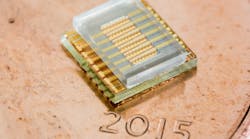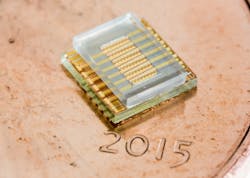For Menlo Micro, the Material is the Message
The importance of materials to high-frequency design is often overlooked. However, that is far from the truth at Menlo Micro, where the company has leveraged its knowledge of materials under adverse conditions into a line of miniature micromechanical switches capable of handling high power levels at RF/microwave frequencies. Building from research begun at General Electric's Global Research Center to improve the reliability of that company’s industrial products, the engineers at Menlo Micro have developed proprietary metal alloys and processing techniques that have made possible miniature switches with outstanding power-handling capabilities. The company had examples of its material-based Digital Micro-Switch (DMS) technology on display at EDI CON booth #227.
DMS technology uses proprietary metal alloys fabricated on glass substrates to achieve broadband microwave switches capable of high power-handling capabilities. (Courtesy of Menlo Micro)
As the title of their EDICON workshop, “From Milliwatts to Kilowatts: Advanced Material Science Enables High-Temperature, High-power Micro-Mechanical Switches,” scheduled for today at 1 p.m. in room 109, suggests, these miniature switches can handle many times the power levels of conventional micro-miniature switches, including components fabricated with silicon-on-insulator (SOI) technology. The switches are made from metal alloys plated onto glass wafers with through-glass vias (TGVs) from a company that is not only a supplier, Corning Inc., but an investor as well.
These novel switches not only achieve high power-handling capabilities, typically 15 to 20 dB better than what had been possible with conventional microwave switches, but they feature less than 0.3 dB insertion loss at 12 GHz and can cover frequency bandwidths from DC to 18 GHz, with the capability of handling millimeter-wave frequencies and bandwidths.


